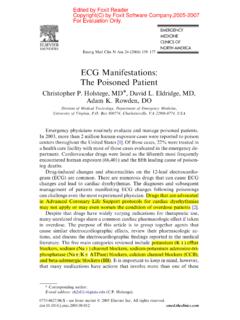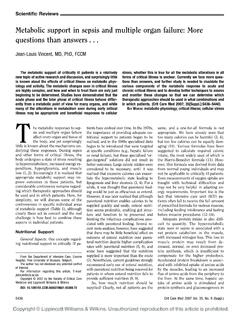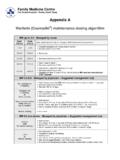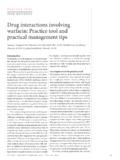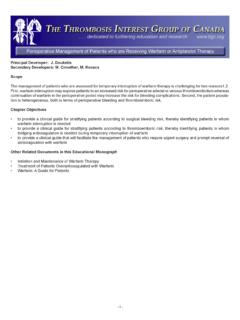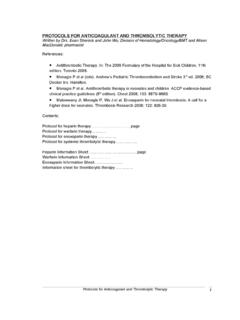Transcription of Coagulation defects in trauma patients: etiology ...
1 Coagulation defects in trauma patients : etiology , recognition , and therapyThomas G. DeLoughery, MDDivisions of Medical Oncology/Hematology and Laboratory Medicine, L586 Oregon Health &Science University, 3181 SW Sam Jackson Park Road, Portland, OR 97201-3098, USAH emostatic complications are common in trauma patients . These coagulationdefects may be related to many processes, ranging from pre-existing disease tocomplications of therapy . This article reviews the causes of hemostasis defects ,how to recognize them, and how to treat Coagulation defects that occur in trauma patients are complex in origin(Box 1). Often, these abnormalities are caused by many interrelated factors. Themost common reasons for abnormal Coagulation laboratory test results in thesepatients are dilution of hemostatic factors by fluid or blood resuscitation, severehypothermia, tissue damage from trauma , and effects of underlying , it seems obvious that if large amounts of fluid and packed redcells are given to patients , their plasma proteins (including Coagulation factors) willbe diluted [1].
2 In trauma patients , however, the situation is more complex. Fluid canshift to extravascular spaces; plasma proteins continue to be produced, and factorsare being consumed. Studies have shown that dilution is often not an issue untilover one blood volume (10 to 12 units of red cells) is given to a patient [2,3]. It isimpossible to predict how an individual patient will respond to studies have demonstrated poor correlation between the amount of bloodproducts given and Coagulation defects [4 7]. In Counts study [5], a very lowcorrelation was seen with the amount of blood given and decreases in specific0749-0704/04/$ see front matterD2004 Elsevier Inc. All rights (03)00089-7E-mail Care Clin 20 (2004) 13 24factor levels, with the r2ranging from to Giving prophylactic plateletshas been shown not to be an effective strategy for preventing defects [8].
3 Patientswith disseminated intravascular Coagulation caused by trauma may have severecoagulation defects even before the first transfusion. For these reasons, one needsto use specific monitoring of Coagulation status and not rely on simplistic formulasfor predicting factor patients are prone to hypothermia [9,10]. patients may be out in thefield for a prolonged period of time and be hypothermic on arrival [11]. Packedred cells are stored at 4 C, and the infusion of one unit can lower the bodytemperature by C [12]. Infusion of fluids at room temperature can lower thetemperature by C for every liter infused. Exposure of viscera during surgerycan result in profound cooling of the has profound effects on the Coagulation system that are associatedwith clinical bleeding [9,13,14].
4 Coagulation occurs because of enzyme reactionsthat are temperature dependent. Even modest cooling slows these reactions,rendering the patient coagulopathic. For example, the Rohrer study showed thatthe activated partial thromboplastin time (aPTT) lengthened from 36 seconds at37 C to 39 seconds at 34 C and to 46 seconds at 31 C [15]. In addition, all facets ofplatelet function decline with modest hypothermia [13,16]. Finally, hypothermiastimulates fibrinolysis, which can provoke more diffuse bleeding. Thus, evenmodest hypothermia can augment bleeding 1. Coagulation defects : etiologiesDilution of Coagulation factorsHypothermiaSlowing down Coagulation factor enzyme functionPlatelet dysfunctionEnhanced FibrinolysisTraumaHead trauma disseminated intravascular coagulationUnderlying diseaseHemophiliavon Willebrand diseaseLiver DeLoughery / Crit Care Clin 20 (2004) 13 2414 TraumaThe key stimulus for Coagulation is tissue trauma .
5 The most profound exampleis head trauma [17,18]. patients with severe brain injuries often have severedefibrination caused by exposure of the thromboplastin-rich brain tissue to flowingblood. These patients may present with severely deranged hemostasis characterizedby fibrinogens below 50 mg/dL. They have severe consumptive coagulopathiesand may require large amounts of blood products. Because the liver is the source ofmost Coagulation proteins, severe liver injury or significant shock results in failureof the body to compensate for consumption of Coagulation not as spectacular as brain injuries, any type of severe trauma that isassociated with extensive tissue damage results in disseminated intravascularcoagulation (DIC). There is also evidence that fibrinolysis may be activated intrauma patients , further amplifying the propensity for bleeding [19,20].
6 Underlying diseaseTrauma is not restricted to previously healthy people. patients with underlyingcoagulation defects often enter trauma systems and tend to do worse. Hemophiliacsmay have impressive bleeding with their injuries. A rapidly emerging problem isthe growing number of the population taking oral anticoagulants. The indicationsfor long-term anticoagulation are increasing, and these patients are being seen morefrequently in the trauma with liver disease are particularly problematic and have a significantlyhigher mortality with trauma , in part because of their underlying hemostatic defects [21,22]. patients with severe liver disease have multiple Coagulation defects [23].All major Coagulation factors and inhibitors are synthesized solely in the liver,except factor VIII and von Willebrand factor.
7 patients with liver disease arethrombocytopenic and have evidence of platelet dysfunction. Liver disease is themost common cause of primary fibrinolysis because of a drop in plasma levels offibrinolytic inhibitors and delayed clearance of plasmin. Evidence of fibrinolysiscan be found in 30% of patients with end-stage liver many as 1 in 100 patients have inherited Coagulation defects . Most commonis von Willebrand disease, which is associated with excessive persistent bleedingafter trauma [24]. Most patients with von Willebrand disease have a history ofexcessive bleeding with minor procedures and a propensity for bruising. If notrecognized, patients with von Willebrand disease can have on-going bleedingdespite surgical management.
8 One in 10,000 male patients has hemophilia [25].These patients may exsanguinate with trauma unless specific factor replacementis 1% of the population takes warfarin. Several studies have shown thatpatients taking warfarin have higher morbidity and mortality when they presentwith intracranial hemorrhage [26,27]. It has been difficult to show that anti-coagulated patients do worse with trauma , however, perhaps because these patientsare identified early and receive plasma [28]. DeLoughery / Crit Care Clin 20 (2004) 13 2415 RecognitionPatients who bleed from Coagulation defects have generalized bleeding frommultiple sites. These patients have diffuse oozing in the surgical field, bleedingfrom intravenous (IV) sites, and ongoing blood loss into drains.
9 A bleedingdiathesis is confirmed by laboratory testing, but in emergency situations, therapyshould be given while awaiting the results of testingThe basic tests of Coagulation are the platelet count, prothrombin time (PT INR), the aPTT, and the fibrinogen level (Box 2).Platelets are essential for initial hemostasis in that they form the platelet is the largest determinant of microvascular bleeding in mas-sively transfused patients . In massively transfused patients , maintenance of theplatelet count at 50,000/mL or higher results in less microvascular bleeding [5,19].Platelet dysfunction also has been reported with trauma . There still is not a simplemethod for reliably measuring platelet function, however. Bleeding times aredifficult to perform and not predictive of bleeding [29,30].
10 Recently, a rapidautomatic test for platelet function, the PFA 100, was introduced [31]. It isunknown, however, whether measuring platelet function is helpful for the man-agement of Coagulation defects in trauma PT INR is a measure of the tissue factor VII pathway. It is sensitive to lowlevels of factor VII and is often mildly prolonged ( to ) in the trauma elevations of the PT INR reflect isolated factor VII deficiency and are notindicative of severe Coagulation defects . It appears that INR elevations are notBox 2. Specific testingKey hemostatic testsPlatelet countHematocritINRA ctivated partial thromboplastin timeFibrinogenTests for more complex situationsThromboelastographyPlatelet function analysisEuglobulin clot lysis timeSpecific factor DeLoughery / Crit Care Clin 20 (2004) 13 2416indicative of the risk of generalized bleeding unless they are over and areassociated with an elevated aPTT [6].
